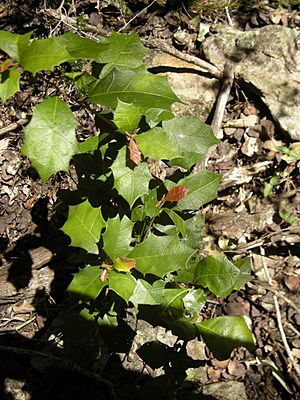Native holly facts for kids
Quick facts for kids Native holly |
|
|---|---|
 |
|
| Mount Archer National Park, Australia | |
| Scientific classification | |
| Genus: |
Alchornea
|
| Species: |
ilicifolia
|
| Synonyms | |
|
|
The Alchornea ilicifolia, often called the native holly, is a type of bush found in eastern Australia. You can spot it growing in or near the edges of drier rainforests. Its natural home stretches from Jamberoo, New South Wales all the way up to Atherton, Queensland.
Contents
What's in a Name? The Native Holly's Story
Have you ever wondered how plants get their scientific names? For the native holly, it started with a botanist named John Smith. In 1839, he first described this plant, calling it Caelebogyne ilicifolia. He used three samples collected by Allan Cunningham in 1829.
Later, in 1865, a Swiss botanist named Johann Müller gave it the name we use today: Alchornea ilicifolia. The first part of the name, Alchornea, is a tribute to an English botanist named Stanesby Alchorne. The second part, Ilicifolia, is a clue about its appearance. It means "holly-leaved," because its leaves look a lot like those of the holly plant.
Did you know that the leaves of the native holly are also a tasty meal? They are eaten by the young larvae of the Common Albatross butterfly!
Meet the Native Holly: Description
The native holly is usually a shrub, but sometimes it can grow into a small tree. It can reach up to 6 meters (about 20 feet) tall. Its main stem, or trunk, can be about 10 centimeters (4 inches) wide.
The trunk of this plant is often a bit bent or crooked. It has smooth, pale grey bark. You might also see some small bumps or spots called lenticels on the bark. The smaller branches are usually greenish or fawn-colored, also with lighter lenticels.
Leaves: Like a Holly
The leaves of the native holly truly live up to their name! They look very much like holly leaves. Each leaf is usually between 2 to 8 centimeters (about 1 to 3 inches) long and 2 to 5 centimeters (about 1 to 2 inches) wide. They are often oval or diamond-shaped.
Each leaf has three or four sharp, pointed "teeth" on each side. The very tip of the leaf is also sharp and pointed. These leaves feel stiff and don't have any hairs. The underside of the leaves is usually a paler color. The short leaf stalks are only about 3 millimeters long. You can easily see the veins on both sides of the leaves. There are three or four side veins that branch off the main vein almost at a right angle, and they end in a sharp point.
Flowers and Fruit: How Native Holly Reproduces
The native holly produces greenish flowers in November. These flowers grow in clusters called racemes. An interesting fact about this plant is that it has separate male and female flowers, and they grow on different plants! This means you need both a male and a female plant for fruit to form.
The fruit of the native holly is a dark brown capsule. It's about 6 millimeters (a quarter of an inch) across and usually has three rounded sections, or lobes. Each section typically holds one seed. The fruit usually ripens between September and November, but you might see it at other times of the year too.
It can be tricky to grow new native holly plants from seeds. However, if you take cuttings (small pieces of the plant), they usually grow roots and start new plants quite well!
Uses of Native Holly
The native holly is a lovely plant to have in a garden. It makes an attractive shrub. It's also great for creating a hedge because it grows slowly and can be shaped nicely.

